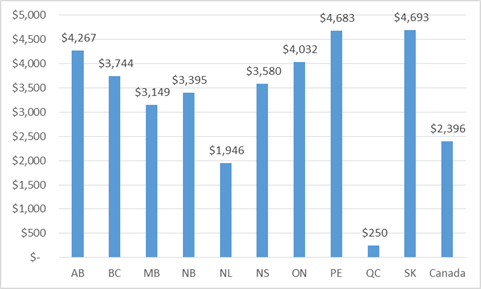Statistics Canada, for reasons best known to itself, only tracks tuition for university programs. For college programs, we’re basically in the dark. We’ve got nothing, nada, zip.
In theory, it’s not all that difficult to work out. All you need to know is price and enrolment for each program offered: sum the prices, divide by enrolment, and voila! Average tuition. And yet nobody does it (my guess for why Statscan doesn’t do it? Something less than full confidence in the enrolment data that comes in from colleges).
(Actually, Canada’s not alone in this. In truth, there are very few countries with accurate tuition indexes. Most countries either have zero tuition, or a set tuition fee, or fees [under Australia’s HECS system, students pay one of three prices depending on what fields of study they are in, with no variation by institutions], or they have a huge multiplicity of prices, often due to having many private institutions. Almost no one keeps track of what goes on in private sectors, which is why you will search in vain for decent statistics on tuition in places like Brazil, Mexico, Russia, or even China for that matter. The miracle has more to do with the fact that we have a decent set of tuition statistics for universities – albeit ones with some pretty loopy characteristics, as I noted back here – rather than the fact we don’t have one for colleges. But I digress.)
The more faithful among you may remember that we here at HESA Towers tried to come up with a college tuition figure a few years ago. In retrospect, our numbers were probably a little high in at least one province (Saskatchewan). So this time, we think we’ve fixed the problems, and are giving it another shot.
Here’s how we came up with our numbers. We looked at posted prices on institutional websites, and then – where tuition varies across programs – came up with an enrolment-weighted average fee for diploma-level programs (both shorter and longer programs are excluded from these calculations). In Newfoundland, Nova Scotia, New Brunswick, Prince Edward Island, and Saskatchewan there is only one institution, so the calculation is relatively straightforward. In Alberta, an estimated enrolment-weighted tuition figure for diploma-level programs was provided to us by the provincial government. In these six provinces, we are pretty confident about our numbers.
In the other four provinces (Ontario, Manitoba, British Columbia, and Quebec), we did not do a census of institutions; instead, we obtained fee and enrolment data from a representative sample of college institutions, enrolment-weighted the fee data, and assigned it to the entire province. I know what you’re thinking: Quebec CEGEPs do not charge tuition. However, they do charge a variety of fees for things like athletics, student services, etc., and we counted those. In these four provinces, there is a bit more of a margin of error in that we are not fully certain how representative our sample is.
Caveats aside, here’s what we found.
Figure 1: Average Tuition in College Diploma Programs
Saskatchewan and Prince Edward Island have the highest average fees, at just under $4,700. This does not of course mean that all students are paying this amount; in fact, most are paying less, but both schools have enough high-tuition programs to pull up the average. In most provinces, the average is somewhere between $3,100 and $4,100, though Quebec and Newfoundland are substantially below that. The national average is $2,396.
That’s the picture for 2014-15 anyway. We’ll try to keep this index up-to-date each year – look for an update on this in September.


 Tweet this post
Tweet this post

Thanks for this excellent data, Alex!
Notwithstanding the important points you raise in the blog, I remain intrigued by the Quebec figure. I wonder how much of that $250 figure is weighted down by CEGEP. If CEGEP figures weren’t included, would the Quebec figure still be <$500?
Not quite sure what you mean. we’re looking at public colleges only so QC college = CEGEP.
As I understand, CEGEP is a two-year program after grade 11 (a program that is unique to Quebec). I’m thinking it would be worthwhile to compare tuition fees in a) other Quebec college diploma programs that a student might pursue after CEGEP, with b) tuition fees for college diplomas in English Canada.
Oh, you mean CEGEP vocational-stream programs? Fees are the same.
The provincial data is interesting, but given the data the central tendency is hard to express. As the text point out, the central tendency is probably between $3100 and $4100. The median of the ten figures is $3657 (half way between BC and Nova Scotia) which corrects for the two outliers. If these numbers are based on the amounts the institutions charge, on average, it would be interesting to learn how much students pay, on average. This is particularly relevant to the national figure when the two least populous provinces are also at or toward the ends of the distribution.
These are the enrolment-weighted provincial averages. As it says in the graph, the enrolment-weighted national average is $2,396.
Thank you, Alex.